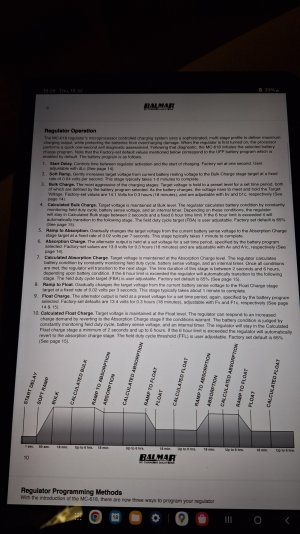scr0che
Active member
I've had a new Balmar 100A alternator fitted with my Volvo MD22A engine (11m yacht), along with an MC-618 external regulator. All working fine, but....
I started the engine the other day with -112ah on my 400ah AGM battery bank (via victron BMV). Having started the engine I looked 3 hours later and it was still at -50ah, and the regulator was in 'float' charge. I was expecting the regulator to recognise the batteries weren't fully charged and to run in baulk for longer than the configured/default 18 minutes (which ran at 60+ amps)? I do have solar power connected as well, but it wasn't a particularly sunny day, so not expecting and interference there.
Should I make a change to the regulator configuration to increase the baulk charging time period from 18 minutes? Or is there some other configuration I should make? Thus far I only changed the battery type to AGM, and set an alternator high temp limit to 86 degrees, and a battery temp high limit to 44 degrees, neither of which have been reached as yet.
Steve...
I started the engine the other day with -112ah on my 400ah AGM battery bank (via victron BMV). Having started the engine I looked 3 hours later and it was still at -50ah, and the regulator was in 'float' charge. I was expecting the regulator to recognise the batteries weren't fully charged and to run in baulk for longer than the configured/default 18 minutes (which ran at 60+ amps)? I do have solar power connected as well, but it wasn't a particularly sunny day, so not expecting and interference there.
Should I make a change to the regulator configuration to increase the baulk charging time period from 18 minutes? Or is there some other configuration I should make? Thus far I only changed the battery type to AGM, and set an alternator high temp limit to 86 degrees, and a battery temp high limit to 44 degrees, neither of which have been reached as yet.
Steve...

